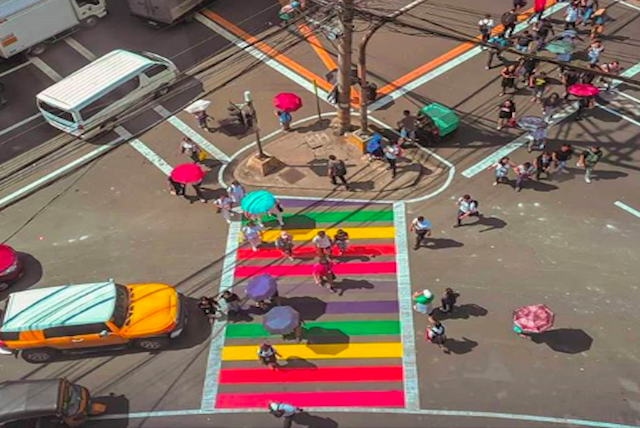
Manila City Mayor Isko Moreno unveiled a rainbow-colored pedestrian lane last week at the corner of Arroceros and Natividad streets. Although this seems like a good move, people weren’t too happy about it. Neither am I.
https://www.instagram.com/p/B388QA6FWRa/?utm_source=ig_web_copy_link
“Pinangako ko sa LGBTQ society that we just want to show you in our own little way how sensitive we are with your plight,” Moreno said in a Facebook live video. He’s also planning to put more rainbow-colored lanes in Manila. Many Twitter users pointed out that there should be a more concrete solution to this, like an “actual anti-discrimination ordinance.”
hot take: if isko moreno really wanted to portray as manila city as LGBTQ+-friendly, i would very much appreciate if he can rally his city council for a local anti-discrimination ordinance instead of "rainbow-colored" pedestrian lanes
— mikee #StopTheKillings #JoinBHKatip (@mikeetsukinoko) October 26, 2019
Ang pointless naman nito, Isko. Sana muna ay napasa ang Anti-Discrim Ordinance. Hindi mawawala ang diskriminasyon kahit na gawin mong Rainbow Land ang Maynila. https://t.co/ciiSS2ZjsW
— Carwyn Candila (@JCRWYN) October 25, 2019
Manila isn’t the first city to show support for the LGBTQ+ community. Quezon City also painted its pedestrian lane in rainbow colors last year to celebrate Pride Month. They are also one of the first cities in the metro to set a gender-fair ordinance.
As much as I appreciate the Mayor’s initiative, it’s not enough to make us feel welcome. Could this just be a publicity stunt so the LGBTQ+ would be in his favor? I know that it’s important to appreciate the little things, but don’t you think that the LGBTQ+ community has been through enough only to get a rainbow-colored lane? We have been fighting for years for our rights, and this is supposed to make us feel better? I don’t think so. There are far more effective ways to make us feel safe. People in the community experience discrimination almost every day of their lives—whether through online bullying or in public places. They have been harassed, judged, ridiculed, and shamed by so many that I don’t think the “little things” can go a long way.
How about an anti-discrimination ordinance in the city, particularly in schools and workplaces? Although the Department of Education (DepEd) enacted a Child Protection Policy in 2012 to address bullying and discrimination in schools, including every SOGIE, it was not adequately enforced. Schools still don’t have enough resources for better knowledge about the LGBTQ+ community. Congress, in 2013, also passed the Anti-Bullying Law, which “implement[s] rules and regulations that enumerate sexual orientation and gender identity as prohibited grounds for bullying and harassment.” Again, not much has changed since then.
Sen. Risa Hontiveros has always been vocal about this, as she was the main author of the “Bawal Bastos Law,” a law that blocks gender-based harassment online and in public spaces. Just today, the implementing rules and regulations (IRR) for this law was finally signed. Heads of agencies and women organizations were present, including DepEd, Commission on Human Rights (CHR), Philippine Commission on Women (PCW), and more.
While Manila still doesn’t have such ordinance, Moreno promised that the city will have its own Pride March and Festival next year. He also noted that he’s interested in hiring more LGBTQ+ members in the city’s government. “Some [members of the LGBTQ community], at the very least, are going to be part of the city government of Manila. They will be part of policy-making, governance, and so on.”
I remember what it felt like when I first saw a rainbow lane in Ayala Malls Circuit in Makati. The project was established by artist and advocate Ralph Eya and Creative Director Andrei Venal, and is aligned with their goal to “create a bigger and stronger LGBTQ+ movement.” My friends and I couldn’t help but take photos of the lane. It made me feel like people are starting to acknowledge our existence. I’m sure many would relate to that. But the thing is, even if they did recognize us, we’re still living in a place where our rights aren’t acknowledged. We’re still walking along the streets of a country that doesn’t accept us. And the question still remains: Why create a special lane for the gays?
And this is why we think that Mayor Isko’s initiative will never be enough. Because at the end of the day, we still face systematic oppression. We are still considered a “threat” to some, especially our senators. The country still lacks laws that protect our rights and putting up colored pedestrian lanes won’t solve the problem—not even a little bit.
Photo courtesy of Mayor Isko Moreno’s Instagram Account
For the latest in culture, fashion, beauty, and celebrities, subscribe to our weekly newsletter here
Follow Preen on Facebook, Instagram, Twitter, YouTube, and Viber
Related stories:
Celebrate Pride all year long with these local LGBT+ films
Protecting trans rights isn’t just about restrooms
Humanizing SOGIE highlights the stories of 23 LGBTQ+ Filipinos
Is creating a third restroom for the LGBTQ+ the solution? The President thinks so.
Understanding the history of the LGBTQ+ community through documentaries


